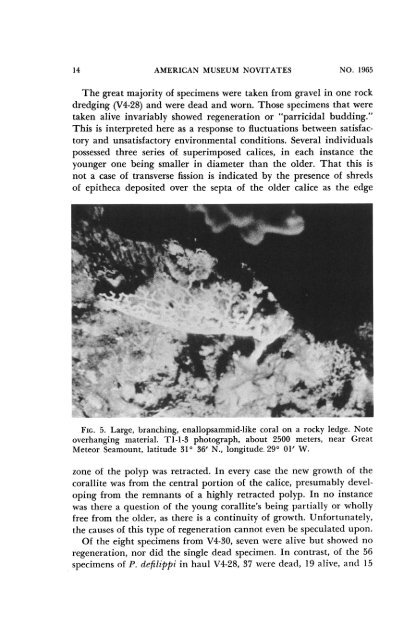MXieuicanJAuscum - American Museum of Natural History
MXieuicanJAuscum - American Museum of Natural History
MXieuicanJAuscum - American Museum of Natural History
Create successful ePaper yourself
Turn your PDF publications into a flip-book with our unique Google optimized e-Paper software.
14 AMERICAN MUSEUM NOVITATES<br />
NO. 1965<br />
The great majority <strong>of</strong> specimens were taken from gravel in one rock<br />
dredging (V4-28) and were dead and worn. Those specimens that were<br />
taken alive invariably showed regeneration or "parricidal budding."<br />
This is interpreted here as a response to fluctuations between satisfactory<br />
and unsatisfactory environmental conditions. Several individuals<br />
possessed three series <strong>of</strong> superimposed calices, in each instance the<br />
younger one being smaller in diameter than the older. That this is<br />
not a case <strong>of</strong> transverse fission is indicated by the presence <strong>of</strong> shreds<br />
<strong>of</strong> epitheca deposited over the septa <strong>of</strong> the older calice as the edge<br />
FIG. 5. Large, branching, enallopsammid-like coral on a rocky ledge. Note<br />
overhanging material. Tl-1-3 photograph, about 2500 meters, near Great<br />
Meteor Seamount, latitude 310 36' N., longitude. 290 01' W.<br />
zone <strong>of</strong> the polyp was retracted. In every case the new growth <strong>of</strong> the<br />
corallite was from the central portion <strong>of</strong> the calice, presumably developing<br />
from the remnants <strong>of</strong> a highly retracted polyp. In no instance<br />
was there a question <strong>of</strong> the young corallite's being partially or wholly<br />
free from the older, as there is a continuity <strong>of</strong> growth. Unfortunately,<br />
the causes <strong>of</strong> this type <strong>of</strong> regeneration cannot even be speculated upon.<br />
Of the eight specimens from V4-30, seven were alive but showed no<br />
regeneration, nor did the single dead specimen. In contrast, <strong>of</strong> the 56<br />
specimens <strong>of</strong> P. defilippi in haul V4-28, 37 were dead, 19 alive, and 15
















